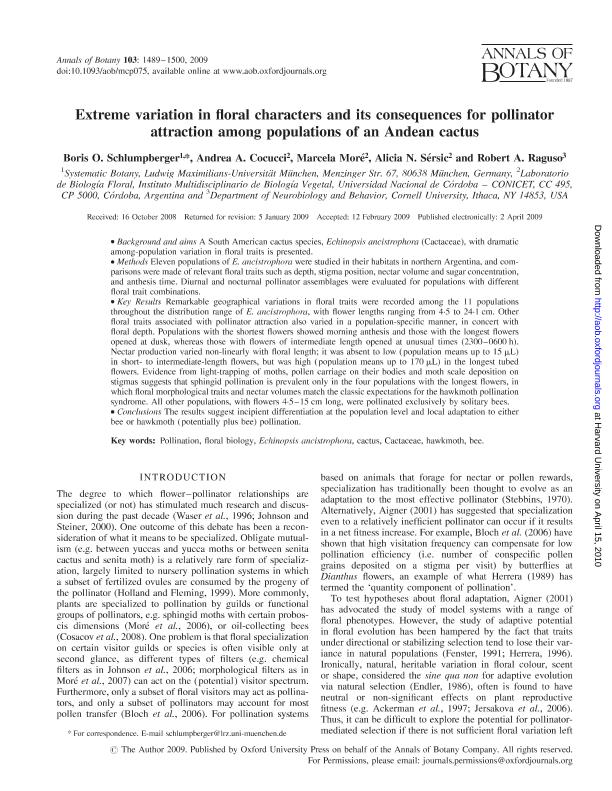Artículo
Extreme variation in floral characters and its consequences for pollinator attraction among populations of an Andean cactus
Schlumpberger, Boris O.; Cocucci, Andrea Aristides ; More, Marcela
; More, Marcela ; Sersic, Alicia Noemi
; Sersic, Alicia Noemi ; Raguso, Robert A.
; Raguso, Robert A.
 ; More, Marcela
; More, Marcela ; Sersic, Alicia Noemi
; Sersic, Alicia Noemi ; Raguso, Robert A.
; Raguso, Robert A.
Fecha de publicación:
04/2009
Editorial:
Oxford University Press
Revista:
Annals of Botany
ISSN:
0305-7364
e-ISSN:
1095-8290
Idioma:
Inglés
Tipo de recurso:
Artículo publicado
Clasificación temática:
Resumen
Background and aims: A South American cactus species, Echinopsis ancistrophora (Cactaceae), with dramatic among-population variation in floral traits is presented. Methods: Eleven populations of E. ancistrophora were studied in their habitats in northern Argentina, and comparisons were made of relevant floral traits such as depth, stigma position, nectar volume and sugar concentration, and anthesis time. Diurnal and nocturnal pollinator assemblages were evaluated for populations with different floral trait combinations. Key Results: Remarkable geographical variations in floral traits were recorded among the 11 populations throughout the distribution range of E. ancistrophora, with flower lengths ranging from 4.5 to 24.1 cm. Other floral traits associated with pollinator attraction also varied in a population-specific manner, in concert with floral depth. Populations with the shortest flowers showed morning anthesis and those with the longest flowers opened at dusk, whereas those with flowers of intermediate length opened at unusual times (2300–0600 h). Nectar production varied non-linearly with floral length; it was absent to low (population means up to 15 mL) in short- to intermediate-length flowers, but was high (population means up to 170 mL) in the longest tubed flowers. Evidence from light-trapping of moths, pollen carriage on their bodies and moth scale deposition on stigmas suggests that sphingid pollination is prevalent only in the four populations with the longest flowers, in which floral morphological traits and nectar volumes match the classic expectations for the hawkmoth pollination syndrome. All other populations, with flowers 4.5–15 cm long, were pollinated exclusively by solitary bees. Conclusions: The results suggest incipient differentiation at the population level and local adaptation to either bee or hawkmoth (potentially plus bee) pollination.
Palabras clave:
Echinopsis
,
Pollination
,
Longue Tongue Hawkmoth Pollination
Archivos asociados
Licencia
Identificadores
Colecciones
Articulos(IMBIV)
Articulos de INST.MULTIDISCIPL.DE BIOLOGIA VEGETAL (P)
Articulos de INST.MULTIDISCIPL.DE BIOLOGIA VEGETAL (P)
Citación
Schlumpberger, Boris O.; Cocucci, Andrea Aristides; More, Marcela; Sersic, Alicia Noemi; Raguso, Robert A.; Extreme variation in floral characters and its consequences for pollinator attraction among populations of an Andean cactus; Oxford University Press; Annals of Botany; 103; 9; 4-2009; 1489-1500
Compartir
Altmétricas



